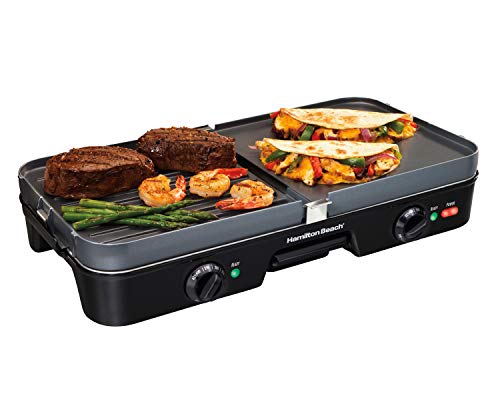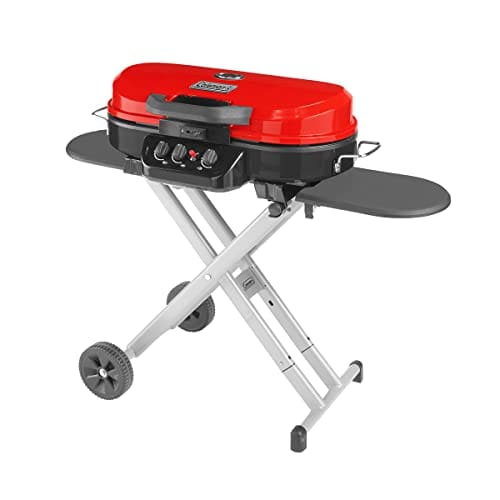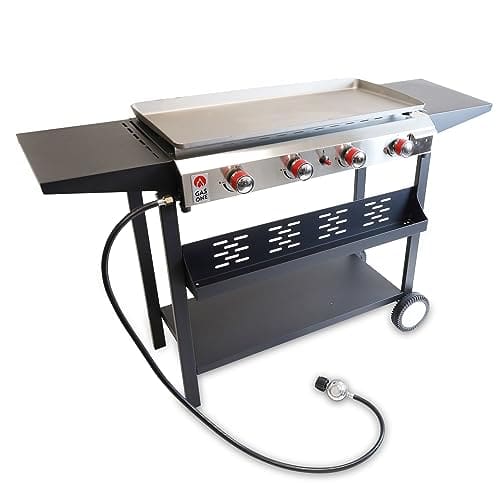How to store and maintain a grill with handles for transport?
This step-by-step guide is designed to help you store and maintain a grill with handles for easy transportation. Whether you are an avid camper, a frequent tailgater, or simply someone who needs to move your grill from one location to another, this guide will provide you with all the necessary steps to ensure your grill remains in excellent condition. From cleaning and storing to ensuring proper care, this guide will help you maximize the lifespan and functionality of your grill with handles for transport.
Convenient Grilling On-The-Go
Clean the grill
To clean the grill, start by removing any food debris or residue from the grill grates and interior. Use a grill brush to scrub the grates thoroughly, making sure to remove any stuck-on particles. Next, take a damp cloth and wipe down the interior surfaces, including the sides and bottom of the grill. This will help remove any grease or grime that has accumulated. Make sure to clean both the grates and interior after each use to maintain a clean and hygienic grill.
Remove the propane tank (if applicable)
- To remove the propane tank from your grill, start by checking that the gas valve is in the closed position. This will prevent any gas leaks when you disconnect the tank.
- Next, locate the coupling nut that connects the tank to the grill. It is usually located near the grill’s control panel or side burner.
- Use your hand to loosen the coupling nut by turning it counterclockwise. Once it is loose, gently lift the tank off the grill and set it aside in a safe location.
- Remember to store the tank upright and in a well-ventilated area away from any heat sources.
Empty and clean the grease trap
To locate the grease trap or drip pan underneath the grill, start by removing the grill grates. Look for a metal or plastic container situated below the cooking surface. Once you have found the trap, use a scoop or spatula to remove any accumulated grease or drippings and transfer them to a secure container for disposal. Next, fill a bucket or sink with warm soapy water and use a brush or sponge to thoroughly clean the grease trap. Rinse it with clean water and dry it before reassembling the grill.
Detach the handles (if possible)
If your grill has detachable handles, remove them according to the manufacturer’s instructions. Doing so will make the grill easier to store and transport. Follow the steps outlined in the user manual to safely detach the handles from the grill.
Protect the grill with a cover
To protect your grill from the elements, follow these simple steps:
- Place a weather-resistant cover over your grill.
- Ensure that the cover fits securely and covers the entire grill.
- Use a cover made specifically for your grill model, if available.
- Fasten the cover tightly using any straps or fastening mechanisms provided.
- Make sure there are no gaps or loose sections that can expose the grill to rain, wind, or other elements.
- Check the cover regularly for any signs of wear or damage, and replace if necessary.
By following these instructions, you can keep your grill protected and extend its lifespan.
Store the grill in a dry and secure location
Find a dry and secure spot to store the grill, such as a garage or shed. Make sure to keep it away from moisture, as exposure to water can lead to rust and damage. Additionally, ensure that the grill is protected from any potential damage by securing it in a place where it won’t be knocked over or hit by other objects.
Secure the handles for transport
To secure the handles for transport, if they are detachable, reattach them securely. Make sure to use any provided locking mechanisms or fasteners to ensure the handles stay in place. This will prevent any movement or accidental detachment of the handles during transportation.
Use a grill dolly or cart for easier transportation
If your grill is heavy or difficult to move, use a grill dolly or cart. This will make transportation easier and prevent strain on your back and arms. To use a grill dolly or cart, simply place your grill onto the platform and secure it with straps or clamps. Then, push or pull the dolly or cart to easily move your grill to its desired location.
Check for any additional maintenance requirements
Before using the grill again, clean the grates to remove any built-up grease or residue. Simply scrub the grates with a grill brush or use a mixture of warm water and dish soap for a more thorough clean.
Next, inspect the gas lines for any signs of damage or leaks. Make sure the gas supply is turned off, then visually examine the lines for cracks, holes, or loose connections. If you notice any issues, it’s important to fix or replace the gas lines before using the grill again.
Finally, replace any worn-out parts that may need attention. This could include worn-out burner tubes, ignition system components, or rusted hardware. Consult the grill’s manual or contact the manufacturer for guidance on how to properly replace these parts.
Taking these steps will ensure your grill is in optimal condition and ready for safe and efficient use.
Key Takeaways
In conclusion, maintaining and storing a grill with handles for transport requires a few important steps. First, cleaning the grill thoroughly, removing the propane tank, and emptying and cleaning the grease trap are essential. Then, detaching the handles, protecting the grill with a cover, and storing it in a dry location will help prevent damage. Finally, when transporting the grill, ensuring the handles are securely fastened and using a grill dolly if necessary are important. Before using the grill again, it’s always a good idea to check for any additional maintenance requirements. By following these guidelines, you can ensure the longevity and functionality of your grill for years to come.
Necessary Items
Efficient Grill Maintenance
Ensuring Safety With Your Grill Propane Tank
Instructions for Using the Grill with Handles for Transport
- First, ensure that the grill is placed on a stable and safe surface, such as a concrete patio or a levelled ground
- Before using the grill, check if it is properly assembled and all the parts are in place, including the handles for transport
- To move the grill, firmly grip the handles on both sides. Make sure to use your strength evenly to prevent any imbalance
- While moving the grill, keep it at a lower height to maintain stability and prevent any accidents
- Once you have reached the desired location, ensure that the grill is properly positioned and the handles are securely locked in place
- Before using the grill, make sure it is clean and free from any debris or leftover food from previous use
- Start the grill according to the manufacturer’s instructions, ensuring that the lid is open to allow proper air circulation
- While cooking, make sure to monitor the temperature and adjust it as needed to achieve the desired result
- After grilling, carefully move the grill back to its storage area using the handles for transport, following the same precautions as before
- Finally, make sure to clean the grill thoroughly after each use to maintain its lifespan and ensure safe cooking in the future
Frequently Asked Questions about Grills with Handles for Easy Transport
How can handles affect the overall weight distribution of a grill?
Handles can indeed affect the overall weight distribution of a grill. The position and design of the handles can impact how the weight is distributed when carrying or moving the grill.
Firstly, the placement of the handles on the grill can influence the balance of weight. If the handles are positioned closer to the center of gravity, it can help to evenly distribute the weight, making it easier to maneuver. On the other hand, if the handles are located towards one end of the grill, it can create an imbalance and make it more challenging to carry or lift the grill.
Additionally, the design of the handles plays a role in weight distribution. Some handles are designed to be more ergonomic, allowing for a better grip and more comfortable lifting. This can make a significant difference in distributing the weight evenly across your hands and arms.
It’s also important to consider the strength and durability of the handles. If the handles are not strong enough to support the weight of the grill, they may break or bend, causing an imbalance and potential safety hazards.
In conclusion, handles on a grill can affect the overall weight distribution. Consider the placement, design, and strength of the handles when selecting a grill, as they can impact how easy and safe it is to transport and handle the grill.
Are there any safety considerations when using grills with handles for transport?
Yes, there are important safety considerations when using grills with handles for transport. Here are some key points to keep in mind:
- Secure the grill properly: Before moving the grill, ensure that it is securely fastened to the handles. Use any locking mechanisms or support brackets that are provided to prevent the grill from shifting or falling during transport.
- Protect your hands and body: When lifting and carrying a grill, always use proper lifting techniques. Bend your knees, keep your back straight, and use your leg muscles to lift the grill. Avoid straining your lower back by using your core strength.
- Be mindful of the weight: Grills can be heavy, especially if they have a large cooking surface or are made of heavy materials like cast iron. Make sure you are physically capable of safely handling the weight, and consider asking for assistance if needed.
- Avoid tipping or toppling: Grills can be top-heavy and prone to tipping over during transport. Be cautious of any uneven surfaces, bumps, or obstacles that could cause the grill to become unbalanced. Move slowly and carefully to maintain stability.
- Protect the grill surface: During transport, protect the grilling surface to prevent scratching, chipping, or damage. Cover the grates or cooking surface with a heat-resistant material or use appropriate grill covers to prevent debris and dust from getting into the grill.
- Keep children and pets away: Whether you’re moving the grill or it is stationary, always keep children and pets at a safe distance. The handles may pose potential hazards, and grills can become hot during use or shortly after cooking.
























